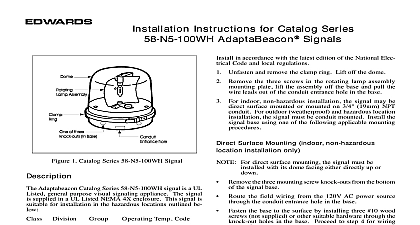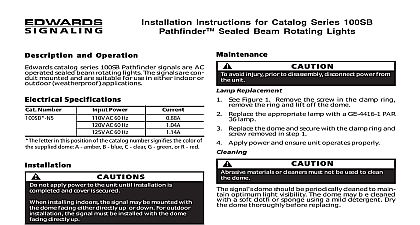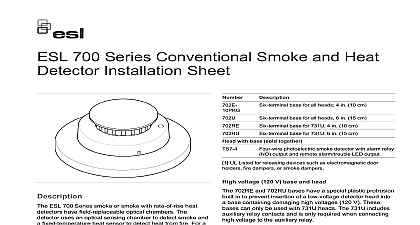Edwards 500N Series Installation Instructions

File Preview
Click below to download for free
Click below to download for free
File Data
| Name | edwards-500n-series-installation-instructions-4015962783.pdf |
|---|---|
| Type | |
| Size | 1.06 MB |
| Downloads |
Text Preview
500N Series Smoke Detector Sheet voltage range selection for UL two wire The two wire 500N Series detectors determine if the detector is connected to a 6 12 V or a 12 24 V panel There are no switches to set features on the model the smoke detector may also provide following features Enables a CleanMe compatible control panel to a warning signal indicating that the optical chamber to be replaced This feature is available on the 500N two wire detectors only 500N Series two wire detectors enable the CleanMe by recognizing voltage polarity at installation If the terminal connections are reversed the CleanMe function enabled New 500N Series detectors are compatible on the loop with previous 500 Series detectors if proper wiring observed See on page 4 temporal three sounder In the 500N models with a piezoelectric horn produces an interrupted 85 dBA when the detector alarms or when the polarity is reversed follows input voltage in reverse polarity order for all sounders to activate when the panel alarms the must reverse the supply voltage polarity to the loop on If the panel does not implement polarity reversal an 405 Polarity Reversal Relay Module must be used Refer the installation sheet for the ESL 405 Polarity Reversal Module and end of line relays Auxiliary relays are Form C operate at 1 A at 30 VDC to allow for the addition of notification devices to the smoke loops Products with in the suffix signify the auxiliary relay feature end of line relay operates as a power supervision relay and normally energized and will release with the loss of power with an in the suffix signify the end of line feature sensors Some models come with rate of rise or fixed heat sensors which allow the unit to detect in temperature that may signal a fire event Models an in the suffix have a heat sensor included models are available with an isolated heat sensor If the senses a temperature change it will alert the panel and an alarm independent of smoke in the photoelectric The heat alarm output is on the alarm relay and the detector output is on the auxiliary relay Models with an in the suffix have an isolated heat sensor which is both rate and fixed temperature This document is intended for licensed electricians or installers We cannot provide technical support to persons If you have any questions contact us the information on page 8 ESL 500N Series conventional two wire and four wire smoke detectors have intelligent software and processed sensing capabilities This intelligence with the ESL patented optical sensing chamber the ESL 500N Series quickly and accurately detects CleanMe compatible software self diagnostics and drift compensation are standard in every unit The ESL Series offers application flexibility with optional auxiliary rate of rise fixed temperature heat sensors isolated sensors and or 85 dBA temporal three sounders features models ship standard with the features described below lock Discourages unauthorized removal of the detector by requiring a screwdriver to remove the from the base Includes automatic sensitivity testing Once day and immediately upon first power up each 500N Series performs a full diagnostic test that includes a dynamic of the sensing chamber and internal electronics This NFPA 72 field sensitivity testing requirements without need for external meters compensation dust compensation The detectors adjust sensitivity up to a maximum of 1.0 ft the detectors become dirty 2014 UTC Fire Security Americas Corporation Inc 8 1036525 EN REV D ISS 30APR14 installations are shown in Figure 1 C The living area detector should be installed in the living room or near stairway to the upper level or in both locations The smoke detector should be installed in close to the stairway leading to the floor above Where on an open joisted ceiling the alarm should be placed the bottom of the joists The alarm should be positioned to the stairway to intercept smoke coming from a fire in basement before the smoke enters the stairway to locate the required smoke detectors in new All of the smoke detectors specified for existing are required and in addition a smoke detector is in each bedroom more smoke detectors desirable The required number smoke detectors might not provide reliable early warning for those areas separated by a door from the areas by the required smoke detectors For this reason it recommended that the householder consider the use of smoke detectors for those areas for increased The additional areas include the basement dining room furnace room utility room and not protected by the required smoke detectors The of smoke detectors in kitchens attics finished or or garages is not normally recommended as these occasionally experience conditions that can result in operation Regulations pertaining to smoke detector installation from state to state For more information contact your fire department or local authority having jurisdiction considerations In addition to NFPA 72 use the location guidelines to optimize performance and the chance of false alarms from the detector ceiling mounted smoke detectors in the center of a or hallway at least 4 in 10 cm from any walls or wall mounted smoke detectors so the top of the is 4 to 12 in 10 to 31 cm below the ceiling Do not locate detectors in or near bathrooms or kitchens smoke alarms in a suitable environment with and humidity as defined in on 8 smoke detectors away from air conditioners registers and any other ventilation source that interfere with smoke entering the alarm Mount smoke detectors on a firm permanent surface refer to the ESL Compatibility Index for a complete of control panels and proper identifiers For a copy of the index see information on page 8 four wire smoke detectors do not require a listing a location a suitable location is critical to the operation of detectors This equipment should be installed in with NFPA 72 Figure 1 shows required and locations 1 Detector location Dining Room Kitchen Living Room Bedroom TV Room Basement Required smoke detectors Additional alarms required for new construction to locate the required smoke detectors in existing The major threat from fire in a family living unit at night when everyone is asleep The principal threat persons in sleeping areas comes from fires in the remainder the unit Therefore a smoke detector is best located the bedroom areas and the rest of the unit In units only one bedroom area on one floor the smoke detector be located as shown in Figure 1 A family living units with more than one bedroom area or with than one floor more than one smoke detector is as shown in Figure 1 B addition to smoke detectors outside of the sleeping areas installation of a smoke detector on each additional story of family living unit including the basement is required 8 1036525 EN REV D ISS 30APR14 the detector wiring must conform to the National Electric Code NEC local codes having jurisdiction Use 12 to 24 AWG 16 22 AWG recommended wire to install the detector you are using the detector base lock remove the knockout and break off the tab on the mounting See Figure 2 Remove the red plastic cover from the detector The is shipped with a cover for protection against site dust Run system wiring to the detector location and mount boxes if necessary The detector fits standard boxes and 3 1 2 in and 4 in round ceiling Line up and attach the mounting base to the electrical box or ceiling using the screws provided Use wall if necessary See Figure 3 Strip the system wires and connect them to the terminals on the d


